Shri Jagat Singh Bisht
(Master Teacher: Happiness & Well-Being, Laughter Yoga Master Trainer, Author, Blogger, Educator, and Speaker.)
Authored six books on happiness: Cultivating Happiness, Nirvana – The Highest Happiness, Meditate Like the Buddha, Mission Happiness, A Flourishing Life, and The Little Book of Happiness. He served in a bank for thirty-five years and has been propagating happiness and well-being among people for the past twenty years. He is on a mission – Mission Happiness!
☆ Positive Education # 05: Positive Engagement ☆
Total absorption in an activity
“A good life is one that is characterized by complete absorption in what one does.”
Jeanne Nakamura and Mihaly Csikszentmihalyi
One thing that brings happiness, for sure, is flow. It is deep engagement in an activity – may it be hobby, work, or play. You lose sense of time, feel completely immersed in the act, and become oblivious of the surroundings.
You must have observed great players perform with highest concentration, despite challenges from the opposition team and distraction from thousands of cheering fans.
Happiness is like a flowing river, not a stagnant pool. It consists in activity – go for a long walk, exercise, do yoga, meditate, sing, dance, paint, play football, swim, travel, or learn a new skill.
Whatever you do, engage fully. Go deep into it, immerse yourself fully – like a musician who becomes one with the musical instrument and the music.
Engage deeply – be it play, work, love, or parenting – and you will experience flow. When you are in flow – deep into music, play, work, reading, or smiling with your child – oblivious of time and self, you are in paradise.
Flow
Flow is total absorption in an activity – you lose sense of time and self. What more could you ask for when you are fully present, immersed in something worthwhile, and there is an exhilarating feeling of transcendence!
Csikszentmihalyi developed a theory of optimal experience based on the concept of flow – the state in which people are so involved in an activity that nothing else seems to matter; the experience itself is so enjoyable that people will do it even at great cost, for the sheer sake of doing it.
Flow is what we feel when we are fully alive, involved with what we do, and in harmony with the environment around us. It is something that happens most easily when we sing, dance, or do sports – but it can happen when we work, read a good book, or have a good conversation.
Flow is the psychology of optimal experience. During flow, people experience deep enjoyment, creativity, and a total involvement with life. The experience of flow makes our life richer, more complex, and intense.
To experience flow, find an activity that you find interesting, that you love to do, that gives you a sense of satisfaction and fulfilment. Do it with full concentration and absorption. Go deeper and deeper into it.
Engage fully to meet the challenges that the task offers by upscaling your skills by continuous learning. Find ways and means to repeat the activity again and again.
Some activities are more conducive for flow experience and seem to have been designed for optimal experience – like singing, making music, rock climbing, games, sailing, and chess.
Yoga and the martial arts are activities that ingrain in us the control of body and its experience. They could be considered as the ultimate exercises leading to optimal experience and flow.
Csikszentmihalyi observes, “The similarities between yoga and flow are extremely strong; in fact, it makes sense to think of yoga as a very thoroughly planned flow activity. Both try to achieve a joyous, self-forgetful involvement through concentration, which in turn is made possible by a discipline of the body.”
You may have an optimal experience with deep involvement in intellectual and scientific pursuits, including reading, writing and poetry, and work.
If one finds flow in work, one is well on the way toward improving the quality of life. People who learn to enjoy their work, who do not waste their free time, end up feeling that their lives have become much more worthwhile.
Plateau Experience
Abraham Maslow coined and defined the term “plateau experience” as a sort of continuing peak experience that is more voluntary and one that requires a lifetime of long and arduous effort.
According to him, “Such people who appear to be in harmony with their lives often have moments of an extraordinary occurrence called ‘peak experiences’.
“These are profound moments of intense rapture and well-being, along with possibly the awareness of ultimate truth and the unity of all things. Accompanying them is a heightened sense of control over the body and emotions and a wider sense of awareness.”
“The best moments in our lives are not passive, receptive, relaxing times. The best moments usually occur when a person’s body or mind is stretched to its limits in a voluntary effort to accomplish something difficult and worthwhile. Optimal experience is thus something that we make happen.”
Mihaly Csikszentmihalyi
♥ ♥ ♥ ♥
Please click on the following links to read previously published posts “Positive Education” 👉
Master Teacher: Happiness & Well-Being, Laughter Yoga Master Trainer, Author, Blogger, Educator, and Speaker
FounderLifeSkills
A Pathway to Authentic Happiness, Well-Being & A Fulfilling Life! We teach skills to lead a healthy, happy and meaningful life.
The Science of Happiness (Positive Psychology), Meditation, Yoga, Spirituality and Laughter Yoga. We conduct talks, seminars, workshops, retreats and training.
≈ Editor – Shri Hemant Bawankar/Editor (English) – Captain Pravin Raghuvanshi, NM





















